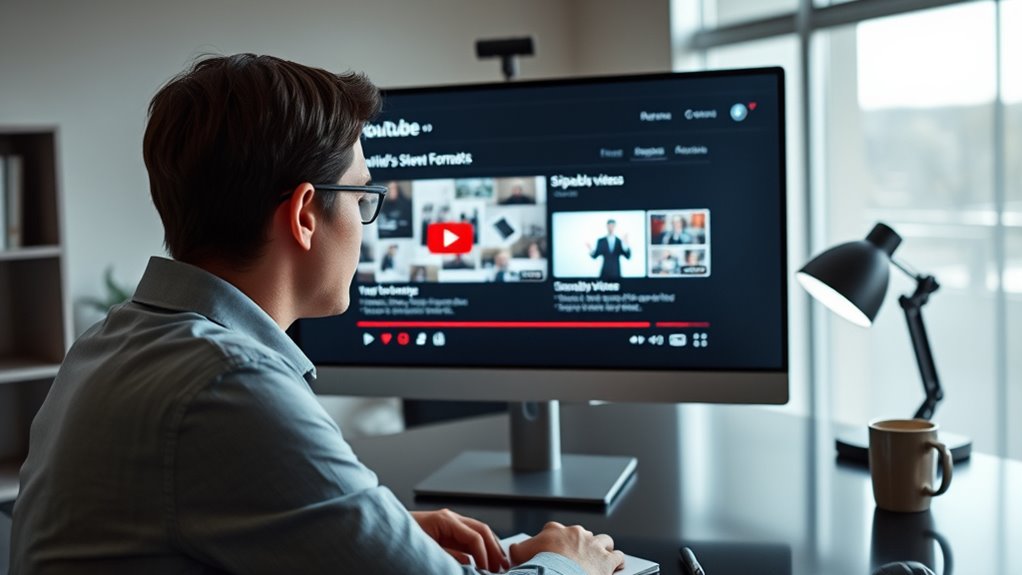YouTube recently made subtle changes to its ad formats, which could impact how your content reaches audiences and how viewers engage with your ads. These updates may affect ad visibility, placement, and effectiveness across devices, potentially shifting engagement metrics. To adapt, you’ll need to monitor performance closely and consider integrating AI content clusters for more precise targeting. Continuing with your current approach might limit your reach; understanding these changes can help optimize your efforts.
Key Takeaways
- YouTube’s subtle ad format updates may alter how ads are displayed across devices, impacting user experience.
- Changes can lead to fluctuations in content visibility and audience engagement levels.
- Integrating AI content clusters can improve targeting and compensate for potential reach reductions.
- Advertisers should monitor performance metrics closely to adapt strategies effectively.
- Ongoing format adjustments require continuous optimization to maintain advertising effectiveness and engagement.

You are trained on data up to October 2023. As a result, YouTube’s recent ad format changes could significantly influence content reach and user engagement, especially when integrated with AI content clusters to optimize advertising strategies.
Frequently Asked Questions
How Will These Changes Affect Ad Revenue for Creators?
You might notice changes in your ad revenue shifts as YouTube adjusts its ad formats. These updates could lead to fluctuations in your creator earnings, depending on how ads are targeted and displayed. While some creators may see a dip, others could benefit from new ad placements. Staying adaptable and monitoring your analytics can help you optimize your content strategy to maximize your creator earnings despite these changes.
Are There New Targeting Options With the Updated Ad Formats?
Ever wonder if new targeting options pop up with updated ad formats? You’ll find that YouTube now offers enhanced audience targeting and ad customization, giving you more control over who sees your ads. These improvements mean you can better reach your ideal viewers, boosting engagement and effectiveness. So, yes, the updated formats bring fresh targeting choices, making your ad campaigns more precise and impactful.
Will Viewer Experience Improve or Decline With the New Ad Types?
You might notice your viewer experience either improves or declines with the new ad types. The changes aim to reduce ad fatigue by offering more relevant options, which can boost viewer engagement. However, if ads become more intrusive or less targeted, it could lead to frustration. Overall, the impact depends on how well these new formats balance relevance and user comfort, influencing your viewing satisfaction.
How Can Advertisers Optimize Campaigns With the New Formats?
To optimize your campaigns with the new ad formats, focus on creating compelling ad creative that captures attention quickly. Use audience segmentation to target specific viewer groups more accurately, ensuring your ads reach the right people. Experiment with different formats to see what resonates best. Continuously analyze performance metrics and refine your approach, adapting your ad creative and segmentation strategies to maximize engagement and conversions effectively.
Are Existing Ad Campaigns Affected or Need Adjustments?
Your ad campaigns might be sailing into uncharted waters, needing some adjustments. The recent format changes could impact format compatibility, meaning your existing ads may not perform ideally without tweaks. To stay ahead, review your current campaigns for necessary ad campaign adjustments, ensuring they’re compatible with the new formats. This proactive approach helps avoid surprises and keeps your ads effective in reaching your audience.
Conclusion
With YouTube’s quiet shift in ad formats, it’s likely these changes aim to boost viewer experience while maximizing revenue. You might find ads less intrusive or more targeted, making your viewing smoother. Trust that these updates are designed to benefit both creators and viewers, aligning with the company’s goal of balancing user enjoyment with monetization. So, stay open to these subtle changes—you might actually enjoy a more seamless, personalized YouTube experience soon.










